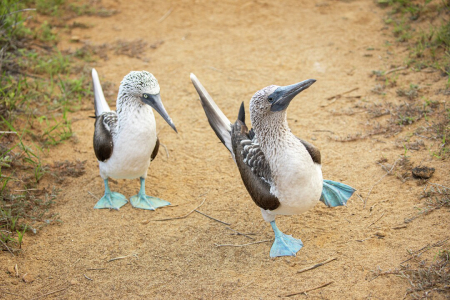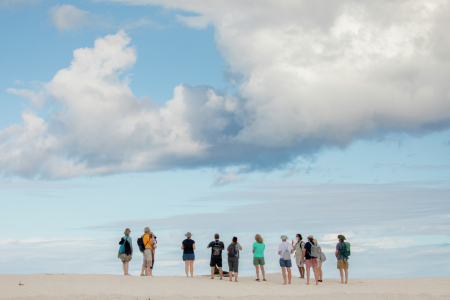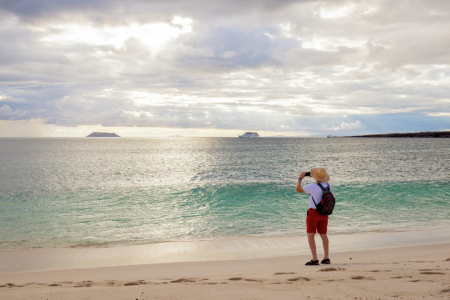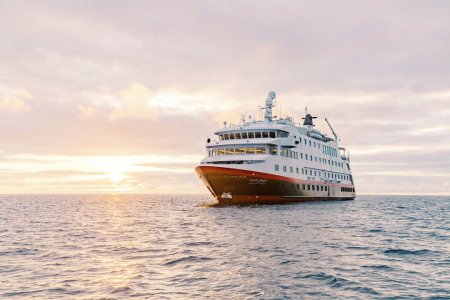Sustainable Tips for Visiting the Galápagos

Photo: Blue-footed Booby birds on Punta Pitt, San Cristóbal Island - Photo Credit: Ashton Ray Hansen / Hurtigruten Expeditions
Few parcels of land and slices of life are as unblemished by humanity as the Galápagos. Here, Mother Nature has had plenty of time to play in the evolutionary sandbox undisturbed — the world didn’t hear about their existence until 1535! While many changes to the isles’ ecosystems have taken place in the last 470 years, there’s still plenty to witness here that you couldn’t find anywhere else on Earth. Here’s a few quick tips on how to visit the islands without leaving your mark.

Photo: Group visiting Mosquera Islet, a tiny Galápagos island - Photo Credit: Ashton Ray Hansen / Hurtigruten Expeditions
Travel in Small Groups
The larger the group sailing up to Galápagos’ shores, the greater the impact to the environment — hence, you don’t see any of the ultra-massive cruise ships docking here. Not only is it better for the Galápagos if you visit with a smaller group, but it’s better for you as well. Smaller groups allow for a more intimate experience!

Photo: Snorkelling at the coast of San Cristobal island, Galápagos - Photo Credit: Dennis Ballesteros / Hurtigruten Expeditions
Use Reef-Safe Sun Protection
While your trip to the Galápagos will likely include the chance to snorkel in the crystal-clear water, studies have shown that chemicals in sunscreen (typically oxybenzone, octinoxate and parabens like butylparaben) are of one the causes of the declining health of coral. Consider wearing sun-protective clothing to reduce your need for sunscreen, and choose a non-nano, mineral-based formula sunscreen with good water resistance. Bonus points if it’s a rub-on lotion! Spray-on sunscreens can often land on the surrounding sand and wash into the ocean.

Photo: Man taking picture from Mosquera Islet, a tiny Galapagos island - Photo Credit: Ashton Ray Hansen / Hurtigruten Expeditions
Take Only Photos
It seems like common sense, but people will always surprise you: do not pick anything up and stick it in your pocket. No seashells, coral, volcanic rocks, native wood or flora. Not even a little stone or pebble! Likewise, if you notice souvenirs like these being sold in nearby towns, don’t buy them!
The other half of this advice that you’ve undoubtably heard: leave only footprints (on the designated pathways)! Don’t carve your initials into any of the plants. Don’t “misplace” your empty water bottle on a hike. It’s jarring to realize, but this is one of the few remaining places on Earth where a human presence is not the norm — you are a temporary visitor here. Any carelessness could be the ripple that harms some of the iconic wildlife!

Photo: MS Santa Cruz II at sea - Photo Credit: Clara Tuma / Hurtigruten Expeditions
Travel with a Name You Can Trust
For the sake of delicate ecosystems, the future of travel must be sustainable. Your business is voting for what travel will become — it’s critical that you pick a sustainable choice. That’s why travel agents are always quick to recommend Hurtigruten Expeditions for those looking to discover Earth’s wonder in an ethical way. With a history centered in exploring and operating some of the roughest waters in the world since 1893, Hurtigruten is no stranger to tackling challenges. In the face of encroaching climate change and ecological disaster, they’re leading the charge to change the industry. As the first major travel company to remove non-essential, single-use plastic from their entire fleet, the first to launch hybrid-electric powered expedition cruise ships and one of the few to integrate education about climate change’s consequences on the ecosystems they explore, they’re not just addressing sustainability in travel — they’re leading the charge.
Don't wait to see how else Hurtigruten helps you discover the Galápagos Islands in a safe and sustainable manner.
Reprinted with permission from Travel Leaders Network | Justin Gibson | October 19, 2022
Hero Image by Ashton Ray Hansen / Hurtigruten Expeditions

